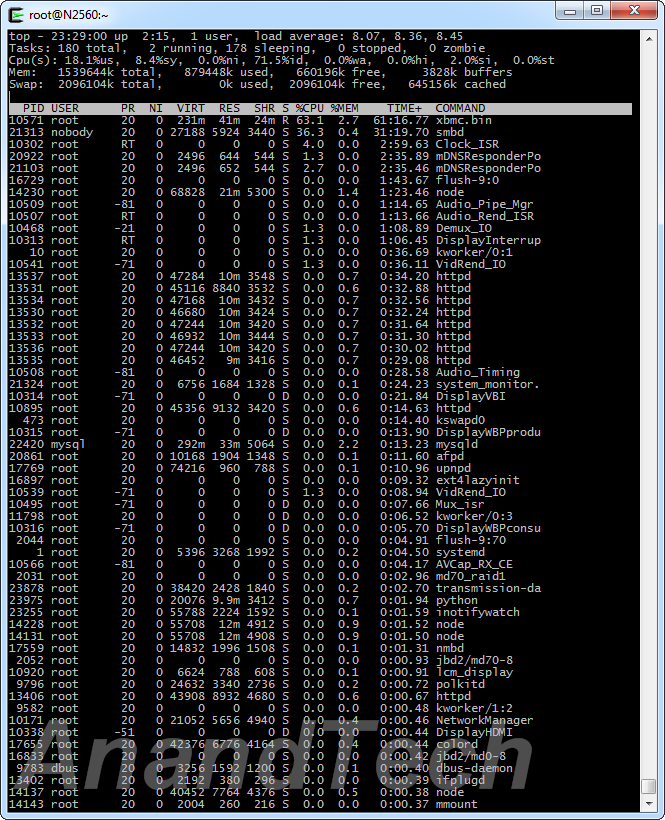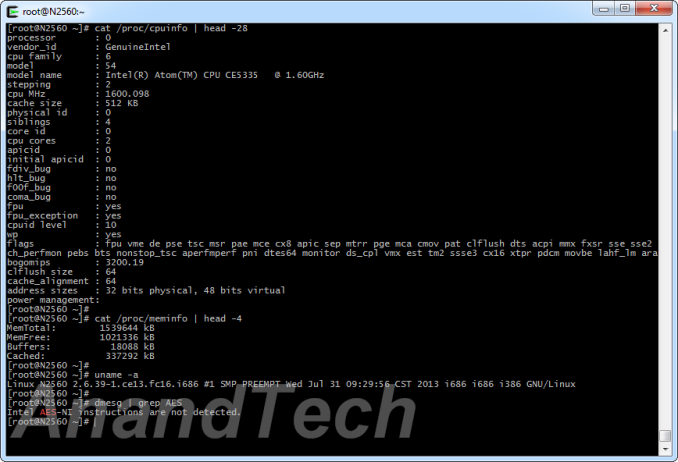Thecus N2560: Intel's EvanSport NAS Platform Review
by Ganesh T S on November 25, 2013 3:30 PM ESTSetup and Usage Impressions
Thecus makes it pretty clear on the package that the N2560 is meant for the average home consumer. There are claims of getting a complete installation up and running in 5 minutes and automatic RAID creation. Quietness and energy efficiency are also touted. The unit comes with a 40W DC adapter (12V @ 3.33A), a 3ft Cat 5 Ethernet cable, CD with firmware and allied software utilities, a warranty card and a quick start guide. The unit has a very plastic feel to it and doesn't look very well built (which is probably OK for a budget NAS).
The more obvious issue is the drive insertion mechanism. Instead of the standard drive bays which involves screwing in the drives, Thecus opts to make things easier for the users by doing away with separate drive holders. Four plastic strips are provided to place on either side of a 3.5" drive and these help in stabilizing them when being inserted into the drive slots. However, the mechanism didn't leave me with a positive impression. On the I/O side, we have both HDMI and SPDIF. These point to the multimedia focus of the N2560.
Internally, the Thecus N2560 uses the Intel CE5335 SoC with the Atom cores running at 1.6 GHz. These are the pervious generation Atom cores, which means no AES-NI support. The unit has 2 GB of RAM, but almost a fourth of it is reserved for the GPU. The OS itself is based on Linux kernel version 2.6.39.
Thecus expects users to use the Intelligent NAS utility (based on Adobe Air) to configure the NAS. While I found it passable to get the unit up and running, I felt more at ease with the browser interface. The Intelligent NAS utility provides information on the various file types stored currently in the NAS, configuration of copy tasks, a provision for firmware update and setup of cloud access with dynamic DNS. All in all, things that the average consumer should be quite happy with when taking advantage of the NAS.
Unfortunately, Thecus hasn't paid that much attention to the browser UI functions, which meant some of the options didn't work as intended. The most obvious issue was the fact that RAID rebuild failed when I tried to test that feature out. Interestingly, this was one of the issues I had reported to Thecus when evaluating the N4800 unit. Thecus units have consistently failed this test and despite the fact that I got the rebuild to work after a couple of attempts, I would have been certainly spooked if I had valuable data on the NAS.
Contributing to the multimedia focus is the presence of XBMC as an installable package. When I tested it out, the interface was restricted to 720p60. There was no HD audio passthrough, and multiple media files from our media streamer test suite just refused to play. I also found that XBMC loaded up more than 50% of the CPU even with the HDMI port disconnected. If one is not using that feature, it is advisable to terminate the process so that the CPU power is available for other NAS functions.

I wouldn't consider XBMC as a killer feature for the N2560. Currently, it is pretty half-baked. We have to wait and watch if Thecus is able to make any progress on this feature which currently seems like a novelty. Thecus claims on their product page that they are working with Intel to get the XBMC app out of the beta phase.
One of the apps available on the N2560 is the Plex Media Server. While trying to play back media on a mobile device with transcoding, we found that Plex doesn't take advantage of the transcoder built into the CE5335. With a single stream, CPU usage went up as high as 90%. Without taking advantage of the hardware transcoder, it is not going to be possible to stream multiple videos to multiple mobile devices.
In terms of miscellaneous features, we find that the N2560 doesn't support iSCSI or NFS. While the former can be excused in a NAS targeting home users, I find the absence of NFS very puzzling. Many media streamers work well with NFS shares. The N2560 doesn't support encrypted volumes or folders, though that can be excused in this market segment. However, Thecus does claim AES 256-bit encryption support for volumes on its product page. It is supposed to make an appearance in one of the upcoming firmware releases.





























73 Comments
View All Comments
Namisecond - Friday, December 20, 2013 - link
when your wifi software reports a connection at 54mb/s your actual throughput is not going to be or anywhere near 54mb/s.robinthakur - Thursday, November 28, 2013 - link
There are many many devices (such as PS3, 360 etc) which cannot access MKV containers where transcoding is the only option from a NAS or building an XBMC frontend box, which is still quite expensive and leads to one more power hungry device on the network. Being able to run XBMC with a media output from the NAS itself would actually be a much better solution for me as long as the CPU isn't getting hit constantly and the deive is near silent. Some people use Android based XBMC, but if you need lossless HD Audio, codec support and proper refresh rate support, your best, quietest, smallest option is actually a Mac mini running XBMC, but they do cost...YaBaBom - Monday, November 25, 2013 - link
Think users who have laptops/tablets/phones--if they have different devices with different capabilities, it's nice to be able to transcode the content from a high-bitrate original to something that best fits the mobile device. Plex does this automatically via software encoding on Windows boxes--i was really hoping to read that it could use the hardware encoder to do the same thing for multiple users (My old Core2Duo server struggles to do this for just one stream).Nephelai - Tuesday, November 26, 2013 - link
Two pc's each with a data disk. /robocopy once per week. Job done. NAS /shrugganeshts - Tuesday, November 26, 2013 - link
For the average household, 2 PCs at idle will probably consume upward of 40 W (minimum -- assuming they are Atom / Brazos based ones). This one, at load, consumes less than 35 W. You will still miss the mobile app data access functionality and lot of other perks provided by a NAS.Mumrik - Tuesday, November 26, 2013 - link
"However, we never got around to publishing a dedicated review due to severe usability issues with the firmware."No idea how that logic works out. Sounds like it should be a negative review.
ganeshts - Tuesday, November 26, 2013 - link
That was for the Thecus N4800, not the N2560 ; The latter being a 2-bay NAS -- as I mentioned in the summary -- can be an ideal backup target.Hrel - Tuesday, November 26, 2013 - link
"The Thecus N2560 is a 2-bay NAS, and most users are going to use it in a RAID-1 configuration." Based on what? I would only use RAID 0 for a 2 bay NAS. If you mirror you lose half your storage and gain no speed.I've never had a hdd fail on me, so that's not really a concern. But even if I did all the data is backed up to external hdd's as well as the NAS.
What good is a NAS if you have to buy 2 to hold all your stuff? Makes much more sense to have external hdd's as data backup.
Gumby_ - Tuesday, November 26, 2013 - link
For a lot of home users and I'd hedge a guess that for the majority purchasing a 2 bay NAS enclosure, it IS their backup device as well as network attached storage. Should it be? No, is it, probably. Running raid0 would be insanity for this use case.ChoppedBroccoli - Wednesday, November 27, 2013 - link
2 bay NAS with two 1-3TB drives in RAID1 + a service like crashplan is what I am going for (and seems what the majority of users should probably go for).With this you get the following:
* Disk drive failure protection
* Location disaster protection via offsite backup (either Crashplan's servers or your house can burn down)
* 1-3TB of backup space (more than enough for the majority of people)
* Ability to do time machine/windows backups to a partition on these drives wirelessly
* Ability to stream this data to any mobile device
Basically these 2 bay NAS systems really shine when you have a cloud backup service running on the NAS itself.